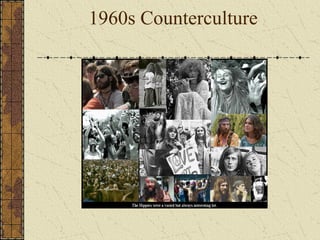
Trail
- 2. The Hippy Movement The term “hippy” comes from being hip. You were either hip or you were a “square” or a “pig.” Hippie were looking for an alternative way to live life. Most hippies valued freedom, nature, intimacy, peace, sharing, and spirituality.
- 3. Way of Life Hippies wanted to distance themselves from mainstream ways of life. They discarded possessions and often lived in parks or campsites in the woods. Living like this made them feel free Nudity was another form of freedom
- 4. Counterculture Fashion Hippies distanced themselves from mainstream culture by their dress. Colorful, flowing clothing, beads, headbands bellbottoms, and tie-dye were popular. Men their hair and beards long or in afros. Hippies were often called “longhairs”
- 5. San Francisco and Haight Ashbury San Francisco was the birthplace of the counterculture/hippy movement. By 1965 hippies had taken over the Haight Ashbury district. Haight Ashbury district contains Golden Gate Park This is a 20,000-strong be-in at home of the Trips Festival Golden gate park in 1967 and “be-ins.”
- 6. Hippy Music The most popular music of the time was psychedelic rock Bands like Jefferson Airplane, Quicksilver Messenger Service, the Jimi Hendrix Experience and the Grateful Dead played free concerts at Golden Gate Park. Concerts and be-ins were places for hippies to protest, socialize, dance, or take drugs. At Woodstock over 250,000 hippies showed up to hear artists like Janis Joplin, The Who, Canned Heat, The Allman Brothers, and County Joe and the Fish.
- 7. Woodstock Woodstock was not just a music concert. “For thousands who couldn’t even hear the music” it was a “profound religious experience.” Meager resources were shared with everyone. Many people at Woodstock used illegal drugs
- 8. Drug Culture Drugs like marijuana and LSD were a big part of the hippy/counterculture movement. Using drugs made hippies feel like the were rebelling from mainstream society. Timothy Leary (a Harvard professor) was an advocate of LSD. LSD was created by a Swiss scientist, used by the CIA, and tested for use by psychiatrists before it became illegal.
- 9. References Wikipedia.com “The Hippy Generation” by Adam Huber http://users.rowan.edu/~lindman/hippieintro.html “What did the hippies Want?” By Alicia Bay Laurel Interview with Terry Brown (my mom) Pictures from Google images: Search: Hippies
- 10. References Wikipedia.com “The Hippy Generation” by Adam Huber http://users.rowan.edu/~lindman/hippieintro.html “What did the hippies Want?” By Alicia Bay Laurel Interview with Terry Brown (my mom) Pictures from Google images: Search: Hippies